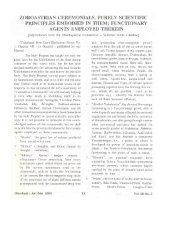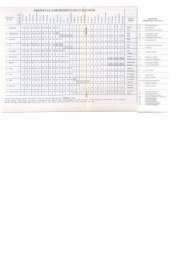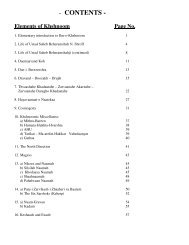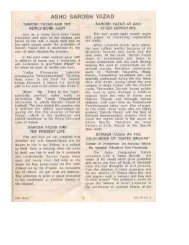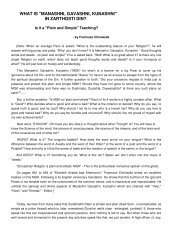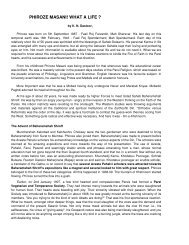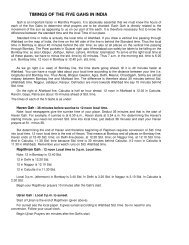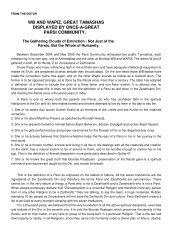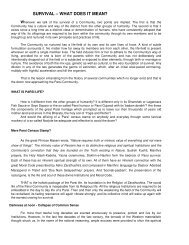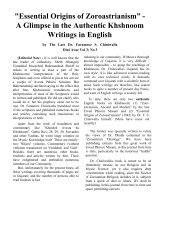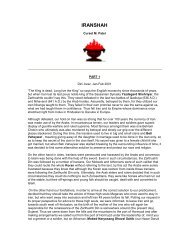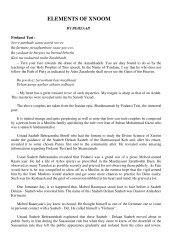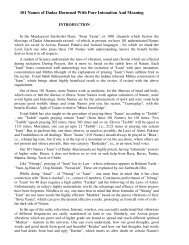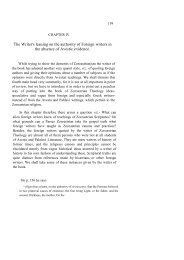Acceptance – Never Ever. - Traditional Zoroastrianism: Tenets of the ...
Acceptance – Never Ever. - Traditional Zoroastrianism: Tenets of the ...
Acceptance – Never Ever. - Traditional Zoroastrianism: Tenets of the ...
Create successful ePaper yourself
Turn your PDF publications into a flip-book with our unique Google optimized e-Paper software.
are <strong>the</strong>re in <strong>the</strong> Universe. Mazdayasni Deen in its pristine sense is not just <strong>the</strong> 'religion' <strong>of</strong> <strong>the</strong><br />
Zoroastrians on earth. In Visperad, Karta 7, para. 2 she is referred to as Astaad Yazat. (Arshtaatem<br />
yazamaidey vangbaveem fraadat gaethaam vareydat gaetbaam savo gaethaam yaam daenaam<br />
Mazdayasneem = "That Mazdayasni Deen, which is Astaad Yazat, i.e. it is a living, throbbing<br />
entity (Kehrp <strong>of</strong> Astaad Yazad), is <strong>the</strong> protector, benefactor, while going through <strong>the</strong> material<br />
world, and one that takes towards permanent salvation, for <strong>the</strong> entire Universe".<br />
Again in Visperad, Karta 12.2-3, some more universal attributes <strong>of</strong> <strong>the</strong> holy Mazdayasni<br />
Deen are given.<br />
In <strong>the</strong> Ashi Yasht, paragraph 16, it is said, "Pita te yo Ahuro Mazdao, yo mazishto<br />
Yazatanaam, yo vahishto Yazatanaam" = "Of thou Ashishvangh, Ahura Mazda, who is <strong>the</strong><br />
greatest <strong>of</strong> all Yazatas, <strong>the</strong> best <strong>of</strong> all Yazatas is <strong>the</strong> fa<strong>the</strong>r." "Maata Armaitish braata te yo<br />
vanghush Sraosho ashyo, Rashnushcha berejo amavao, Meethrascha Vouru-gaoyaoitish yo<br />
baevare spasano hazanghara gaosho" = "Armaiti is <strong>the</strong> mo<strong>the</strong>r <strong>of</strong> Ashishvangh; thy, Ashi's bro<strong>the</strong>r<br />
is benevolent, holy Sarosh, brave, courageous Rashnu, Meher Yazad, who tills <strong>the</strong> vast land to raise<br />
<strong>the</strong> crop <strong>of</strong> Gava, who is ten thousand times <strong>the</strong> supervisor and who has ten thousand ears."<br />
"Khangha Daena Mazdayesnish" = "Thou Ashi's sister is <strong>the</strong> Mazdayasni Deen." Thus, here <strong>the</strong><br />
Mazdayasni Daena is categorically described as a living Yazatic force.<br />
Last, but not <strong>the</strong> least, in our daily Khorshed and Meher Nyaishes, we pray, “Daenaam<br />
vanghuim Mazdayasnim Yazamaidey” = "We attune ourselves to <strong>the</strong> benevolent Mazdayasni<br />
Deen. It is common knowledge that wherever <strong>the</strong> Avesta word, “Yazamaidey” = (a) we attune<br />
ourselves to or (b) as philologists are apt to translate, “We revere or worship”, occurs, it is always<br />
applied to some Divine/Cosmic Force or being operating in Nature, to whom we are supposed to<br />
attune ourselves. In this case, it's <strong>the</strong> Mazdayasni Daena !<br />
The above is <strong>the</strong> original meaning <strong>of</strong> Mazdayasni Deen. In its narrower sense on earth, it has<br />
been compared to <strong>the</strong> trunk <strong>of</strong> a tree. From <strong>the</strong> centre <strong>of</strong> this trunk, <strong>the</strong> main stem or branch that<br />
emerges is <strong>the</strong> Zarthoshti Deen (Zoroastrian Religion). The o<strong>the</strong>r four branches <strong>of</strong> this trunk are <strong>the</strong><br />
four o<strong>the</strong>r religions <strong>of</strong> <strong>the</strong> world, Hinduism, Judaism, Christianity and Islam, which appear in this<br />
world at <strong>the</strong>ir appointed time, after Prophet Zarathushtra has laid <strong>the</strong> foundation for <strong>the</strong>ir coming !<br />
In Avesta, <strong>the</strong>se later religions have been called, apara-tkaesha. As long as all <strong>the</strong>se five<br />
(including Zoroastrian) religions or branches <strong>of</strong> <strong>the</strong> tree keep <strong>the</strong>mselves free from <strong>the</strong> pollution <strong>of</strong><br />
<strong>the</strong> Daevas (dark forces <strong>of</strong> Nature or <strong>the</strong> Blacks), <strong>the</strong>y are known as apara-tkaesha.<br />
If, however, daevaparasti contaminates <strong>the</strong>m, <strong>the</strong>y are known as “aka- Deen” and <strong>the</strong>ir<br />
followers are called dravand or dregvant.<br />
(ii) There remains to be considered <strong>the</strong> o<strong>the</strong>r expression, Haft Keshvar. At <strong>the</strong> end <strong>of</strong> every<br />
Nyaish and Yasht, <strong>the</strong>re is a reference to Haft Keshvar Zamin = seven Keshvars. The term<br />
Keshvar is referred to in Avesta as Karshvare. Karshvare is derived from Karesh = to draw <strong>the</strong><br />
circle. Thus, it implies a circular region. The names <strong>of</strong> <strong>the</strong> seven Keshvars are enumerated in Meher<br />
Yasht, 15.<br />
Now, almost all philologists erroneously believe <strong>the</strong>se Karshvares to be <strong>the</strong> divisions <strong>of</strong> <strong>the</strong><br />
earth or <strong>the</strong> seven continents <strong>of</strong> <strong>the</strong> world. First <strong>of</strong> all, which country or region or continent <strong>of</strong> <strong>the</strong><br />
known material world is "circular"? Secondly, <strong>the</strong> term Karshvare is so derived because <strong>of</strong> <strong>the</strong><br />
14



